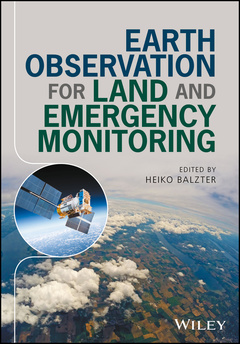Earth Observation for Land and Emergency Monitoring
Coordonnateur : Balzter Heiko

Earth Observation Science (EOS) is the study of the global Earth land-ocean-atmosphere system through observations. The principal tools for such studies are measurements from space since these provide the coverage of the planet that is necessary to capture the behaviour of the entire coupled system. In addition, surface observations, and measurements from aircraft, balloons and sounding rockets provide valuable contributors to what are now termed "integrated, global observing systems.? Coupled with models, the EOS measurement suites provide powerful tools for research into the factors controlling and changing the Earth system in which we live.
The objectives of this book are to describe new methods and applications of satellite technology in the fields of land and emergency monitoring. It draws on new research outcomes from the European FP7 project GIONET (European Centre of Excellence in Earth Observation Research Training). GIONET combines industrial partners with universities and research institutes, and this book provides a perspective on Earth Observation applications that is motivated by the cross-fertilisation of both sectors. Hence, this book will find readers in both industry and academia.
This book highlights a broad range of innovative uses of Earth Observation technology to support environmental management, decision making, crisis management and climate policies. It uses advanced concepts of multi-sensor image integration, multi-temporal analysis and synergies between data and models. This is a truly interdisciplinary subject that encompasses a range of applications in various fields which are discussed in detail throughout the text. If you are interested in remote sensing applications and looking for inspiration, this is the book for you.
List of Contributors vii
Preface xi
1 Earth Observation for Land and Emergency Monitoring Core Services 1
Heiko Balzter
Part I Forest Monitoring 5
2 Methodology for Regional to Global Mapping of Aboveground Forest Biomass: Integrating Forest Allometry, Ground Plots, and Satellite Observations 7
P. Rodriguez-Veiga, S. Saatchi, J. Wheeler, K. Tansey and Heiko Balzter
3 Remote Sensing for Aboveground Biomass Estimation in Boreal Forests 33
M.A. Stelmaszczuk]Górska, C.J. Thiel and C.C. Schmullius
4 Forest Mapping of the Congo Basin using Synthetic Aperture Radar (SAR) 57
J. Wheeler, P. Rodriguez-Veiga, Heiko Balzter, K. Tansey and N.J. Tate
Part II Land Cover and Land Cover Change Monitoring 75
5 Multi]Frequency SAR Applications for Land Cover Classification Within Copernicus Downstream Services 77
B.F. Spies, A. Lamb and Heiko Balzter
6 Unsupervised Land Use/Land Cover Change Detection with Integrated Pixel and Object Based Approaches for High Resolution Remote Sensing Imagery 101
S. Shrestha, C. Smith and Z. Bochenek
7 Earth Observation Land Data Assimilation System (EO]LDAS) Regularization Constraints over Barrax Site 117
M. Chernetskiy, N. Gobron, J. Gómez]Dans, P. Lewis and C.C. Schmullius
Part III Coastal Zone and Freshwater Monitoring 141
8 SAR]Based EO of Salt Marsh Habitats in Support of Integrated Coastal Zone Management 143
S.J. van Beijma, A. Comber and A. Lamb
9 A Framework for Lakeshore Vegetation Assessment Using Field Spectroscopy and Airborne Hyperspectral Imagery 159
D. Stratoulias, I. Keramitsoglou, P. Burai, L. Csaba, A. Zlinszky, V.R. Tóth and Heiko Balzter
10 Copernicus Framework for Monitoring Lake Balaton Phytoplankton 173
S.C.J. Palmer, A. Zlinszky, Heiko Balzter, V. Nicolás]Perea and V.R. Tóth
Part IV Land Deformation Mapping and Humanitarian Crisis Response 193
11 InSAR Techniques for Land Deformation Monitoring 195
P. Kourkouli, U. Wegmüller, A. Wiesmann and K. Tansey
12 Mapping Land Surface Displacements in the Swiss Alps with Radar Interferometry 209
J. Papke, T. Strozzi and N.J. Tate
13 Sample Supervised Search]Centric Approaches in Geographic Object]Based Image Analysis: Concepts, State of the Art and a Future Outlook 223
C. Fourie and E. Schoepfer
Part V Earth Observation for Climate Adaptation 245
14 Remote Sensing of Wetland Dynamics as Indicators of Water Availability in Semi]Arid Africa 247
L. Moser, A. Schmitt, S. Voigt and E. Schoepfer
15 Satellite Derived Information for Drought Detection and Estimation of Water Balance 285
M. Ofwono, K. Dabrowska]Zielinska, J. Kaduk and V. Nicolás-Perea
16 Conclusions 301
Heiko Balzter
Index 305
About the editor
Heiko Balzter is Professor of Physical Geography and Director of the Centre for Landscape and Climate Research at the University of Leicester, UK.
Date de parution : 05-2017
Ouvrage de 336 p.
16.8x24.8 cm
Thème d’Earth Observation for Land and Emergency Monitoring :
Mots-clés :
Earth Observation for Land and Emergency Monitoring; Earth Observation Science; EOS; Earth surface observations; Earth measurements from aircraft; Earth measurements from balloons; Earth measurements from sounding rockets; integrated; global observing systems; EOS measurement suites; Earth system; satellite technology; land and emergency monitoring; European FP7 project GIONET; European Centre of Excellence in Earth Observation Research Training; GIONET; Earth Observation applications; Earth Observation technology; environmental management; environmental decision making; environmental crisis management; climate policies; multi-sensor image integration; multi-temporal analysis; remote sensing applications



